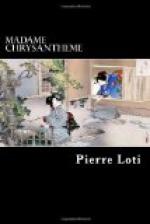In the middle of their official scrawl, they made me write in French my name, Christian name, and profession. Then they gave me an extraordinary document on a sheet of rice-paper, which set forth the permission granted me by the civilian Authorities of the Island of Kiu-Siu, to inhabit a house situated in the suburb of Diou-djen-dji, with a person called Chrysantheme, the said permission being available under protection of the police, during the whole of my stay in Japan.
In the evening, however, up there in our own quarter, our little marriage became a very pretty affair,—a procession carrying lanterns, a festive tea and some music. It was indeed high time.
Now we are almost an old married couple, and we are gently settling down into every-day habits.
Chrysantheme tends the flowers in our bronze vases, dresses herself with studied care, proud of her socks with the divided big toe, and strums all day on a kind of long-necked guitar, producing therefrom plaintive and sad sounds.
VI.
In our home, all has the appearance of a Japanese picture: we have nothing but little folding-screens, little curiously shaped stools bearing vases full of nosegays, and at the further end of the apartment, in a nook forming an altar, a large gilded Buddha sits enthroned in a lotus.
The house is just as I had fancied it should be in the many dreams of Japan I had made before my arrival, during my long night watches: perched on high, in a peaceful suburb, in the midst of green gardens;—made up of paper panels, and taken to pieces according to one’s fancy, like a child’s toy. Whole families of cicalas chirp day and night under our old resounding roof. From our verandah, we have a bewildering bird’s-eye view of Nagasaki, of its streets, its junks and its great pagodas, which, at certain hours, is lit up at our feet like some fairylike scene.
VII.
As a mere outline, little Chrysantheme has been seen everywhere and by everybody. Whoever has looked at one of those paintings on china or on silk that now fill our bazaars, knows by heart the pretty stiff head-dress, the leaning figure, ever ready to try some new gracious salutation, the scarf fastened behind in an enormous bow, the large falling sleeves, the dress slightly clinging about the ankles with a little crooked train like a lizard’s tail.
But her face, no, every one has not seen it; there is something special about it.
Moreover, the type of women the Japanese paint mostly on their vases is an exceptional one in their country. It is almost exclusively among the nobility that these personages are found with their long pale faces, painted in tender rose-tints, and silly long necks which give them the appearance of storks. This distinguished type (which I am obliged to admit was also Mdlle. Jasmin’s) is rare, particularly at Nagasaki.




